Netgear Orbi AXE11000 review: A top-of-the-line mesh router that's overkill for most people
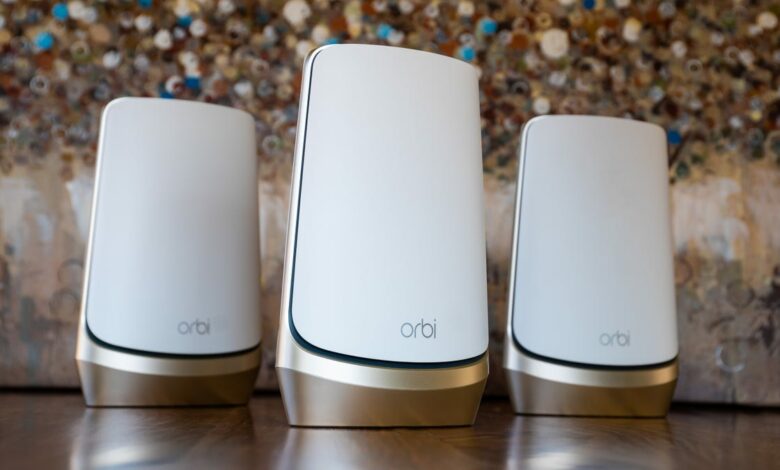
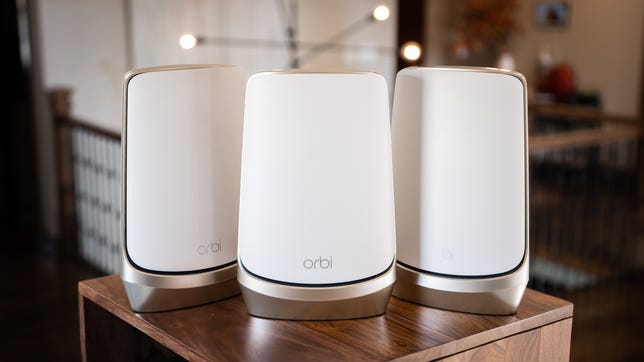
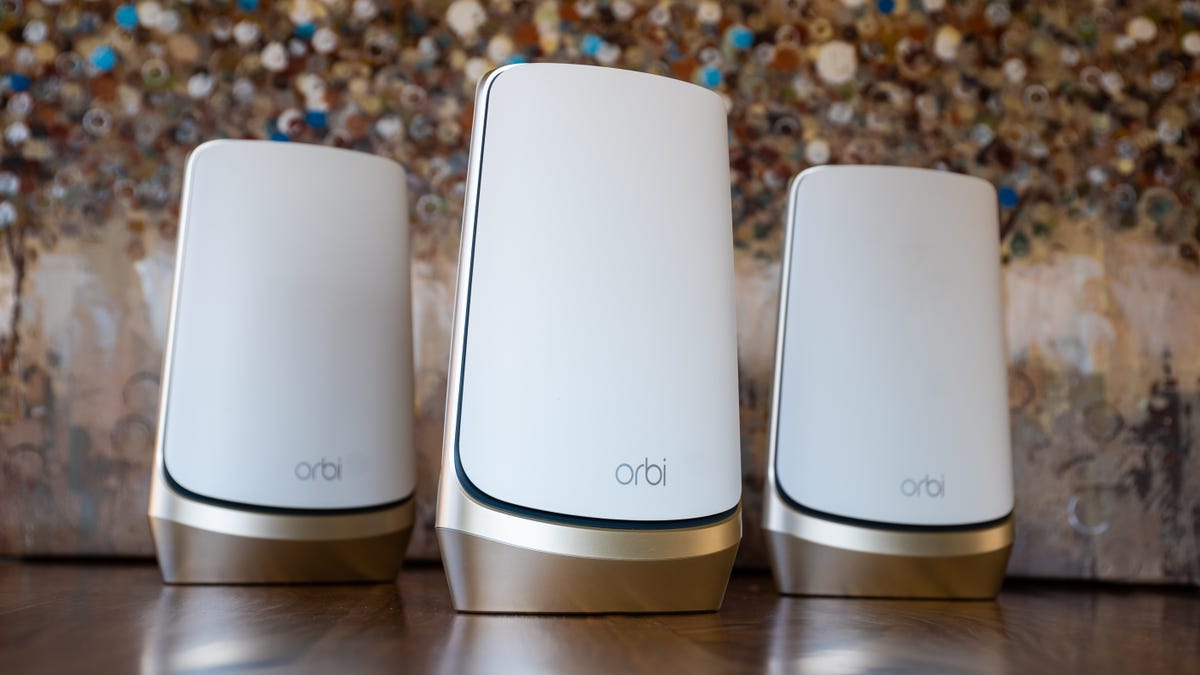
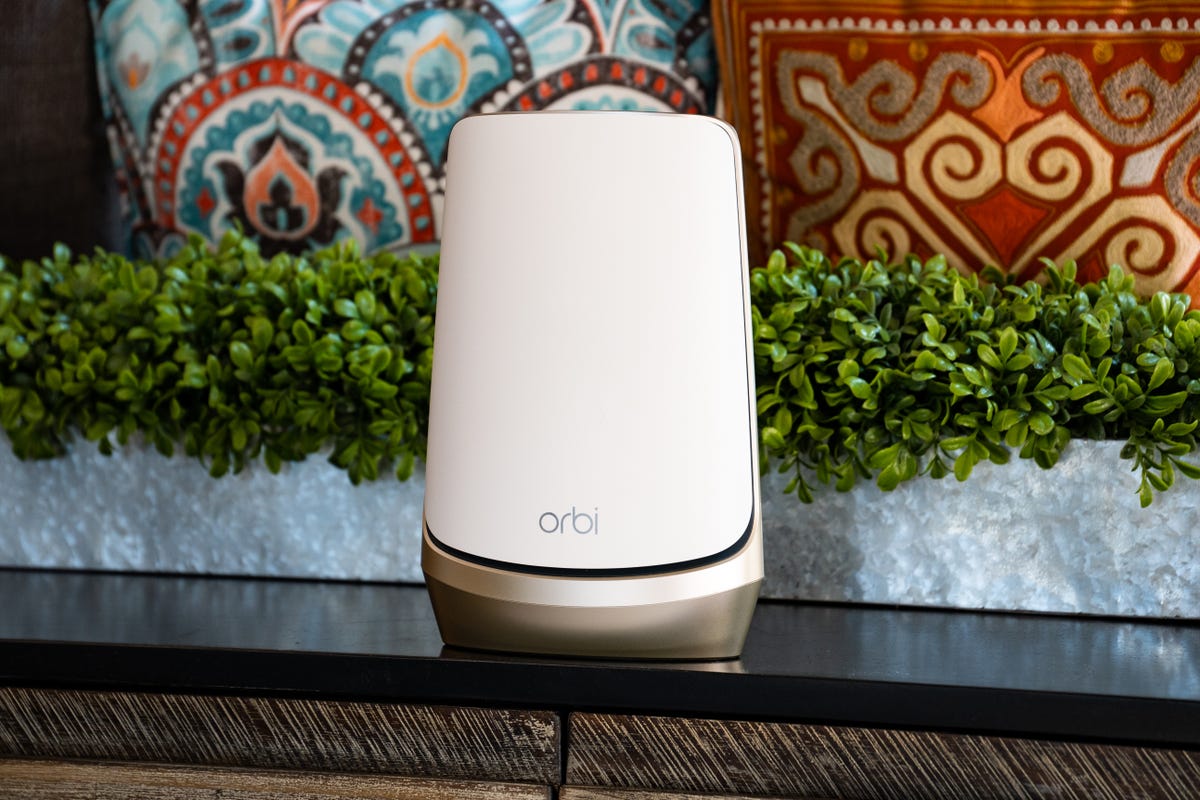
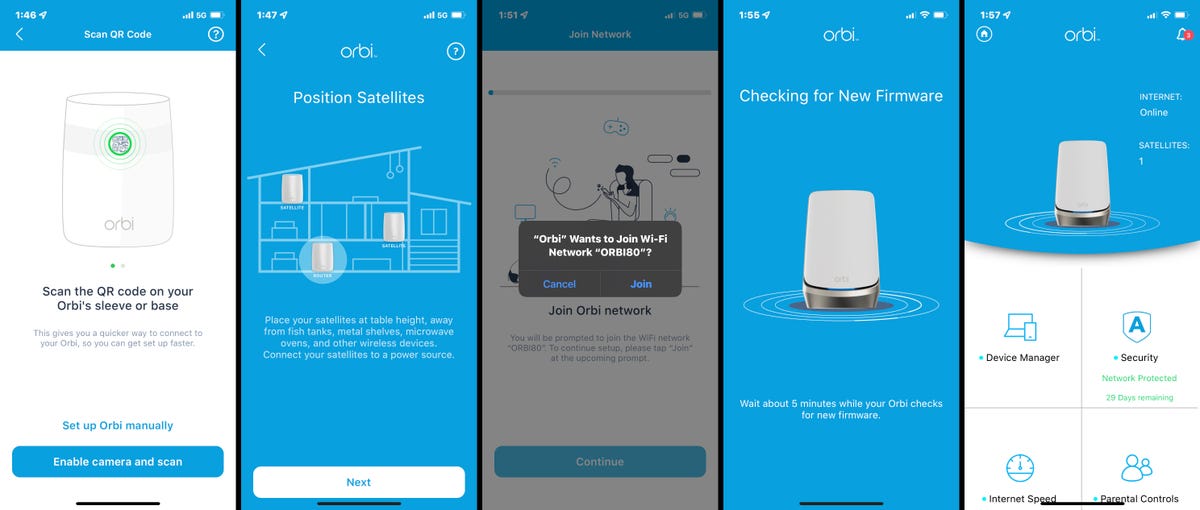


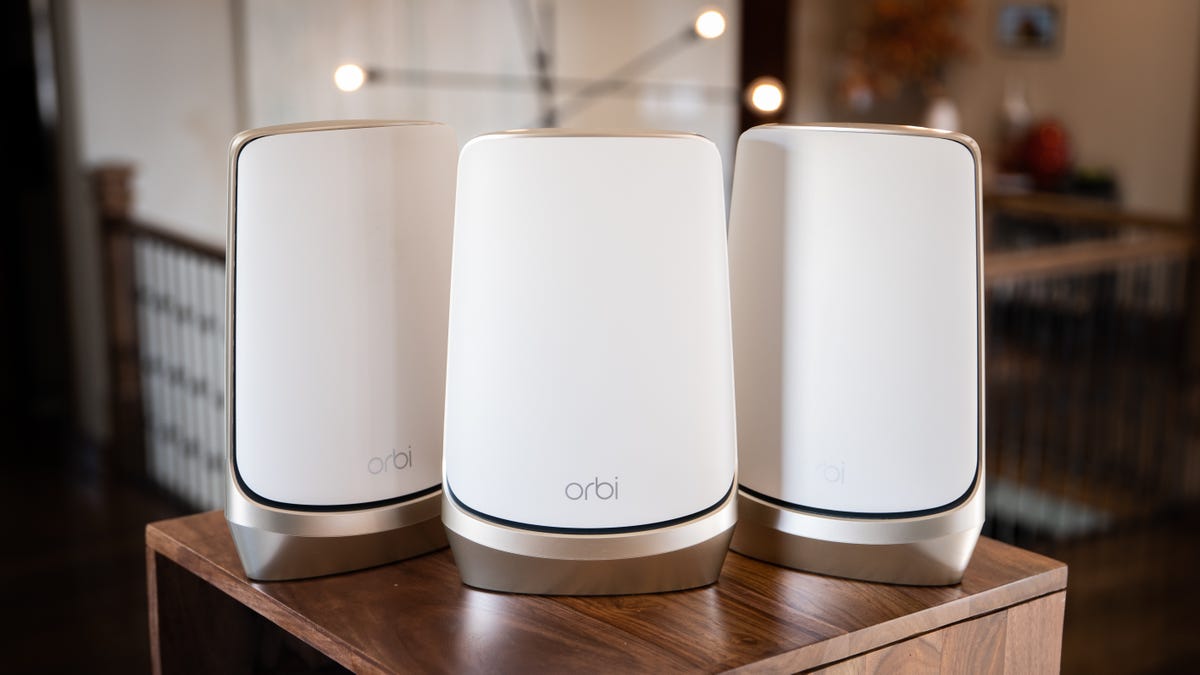

8.1
Netgear Orbi AXE11000 Wi-Fi 6E mesh router
Like
- Powerful performance and fast speeds
- Supports all generations of Wi-Fi, including Wi-Fi 6E connections over 6GHz
- 10Gbps WAN port supports multi-gig internet plans and then some
- Upfront privacy disclosures
Don’t like
- Too expensive to recommend
- Inconsistent routing compromises speeds to a small degree
- Weaker upload range over 6GHz
- Limited control over network settings in Orbi app
Netgear is synonymous with great performance in the router world. It already made the fastest and best-performing mesh router we’ve tested to date, and now it’s added in support for Wi-Fi 6E, a new designation for Wi-Fi devices equipped to operate in the recently opened, ultrawide 6GHz band.
Dubbed the Netgear Orbi AXE11000, the system boasts the usual 2.4 and 5GHz bands, plus a second 5GHz band for backhaul transmissions, plus the new 6GHz band for Wi-Fi 6E connections. When it was released, Netgear dubbed it the world’s first quad-band mesh router — and it comes with a quad-digit price tag, too: $1,500 for a three-pack. At this point, if you’re spending that much money on a router, I’d recommend holding out for a Wi-Fi 7 mesh system, which doubles the channel size — and the potential speeds — of the 6-GHz band that Wi-Fi 6E uses.

For the money, you’re getting one of the most future-proofed routers we’ve ever seen, capable of hitting wireless speeds of up to 2.4 gigabits per second (2,400Mbps) on the 5GHz band, or up to 4.8Gbps for Wi-Fi 6E devices on the 6GHz band. As for wired connections, each device in the system includes a 2.5Gbps LAN port and three additional gigabit Ethernet jacks, while the router’s WAN port supports incoming speeds from the modem of up to 10Gbps.
That would have seemed like overkill just a few months ago, but with internet providers like AT&T, Comcast Xfinity, Ziply Fiber, Google Fiber and others continuing to roll out multi-gig internet plans, high-speed ports like those might be relevant sooner than you think.
Sure enough, the Orbi AXE11000 was an impressive performer when I tested the system out at my home and at the CNET Smart Home — but it wasn’t perfect. With four bands to juggle, the mesh has more work to do as it routes your connection, and the system seemed to struggle with that process a bit more than earlier-gen Orbi setups. It was still able to max out my average speeds in every room of every environment I tested it in, but it wasn’t quite as flawless as its predecessor, the less advanced Orbi AX6000.
That makes this mesh system a bit like a bodybuilder — excessively powerful, but maybe not quite as nimble as it ought to be. It’s mostly a moot point since the system works so well, but it also makes the Orbi AXE11000 tough to recommend for most households, especially up against worthy alternatives that cost considerably less. This is as strong a router as you’d expect for the price, and it might not be long before most of us will want our home networks to support Wi-Fi 6E, but there’s no need to break the bank here.

First impressions
The Netgear Orbi AXE11000 is a mesh system made of three large-sized devices, each equipped with 12 separate internal antennas, high-power amplifiers and a 2.2GHz quad-core processor. Design-wise, they look quite similar to the previous generation of upright, incisor-ish Orbi systems, but the addition of bronze accents at the base gives them an appropriately premium look in comparison. In other words, they don’t just look like Orbi routers; they look like nice Orbi routers — and they’re also available directly from Netgear in an all-black build, which is another nice design touch.
The Orbi AXE11000 router features a WAN port that supports incoming speeds of up to 10Gbps, which is twice as fast as the fastest internet plans in the country.
Each device looks identical, but they aren’t; one of them is your designated router, and it includes the WAN port that you’ll use to connect the system with your modem via Ethernet cable. Conveniently colored in can’t-miss yellow, that WAN port supports incoming speeds as high as 10Gbps, which is twice as fast as the fastest internet plans available anywhere in the US. Don’t expect this system to bottleneck your network speeds anytime soon.
As for the rest of the ports, each device in the system, router and satellites alike, includes a LAN jack that supports wired connections at speeds of up to 2.5Gbps, which is great if you plan to connect the things with an Ethernet cable for a fully wired backhaul. You’ll also find three additional gigabit Ethernet jacks for connecting wired network devices, smart home dongles and other peripherals. You won’t find any USB jacks on any of the devices, which is pretty typical with mesh routers these days, but I still would have liked to have seen at least one here to allow you to connect things like printers and external storage drives to the network.

Setup and app controls
Netgear’s Orbi app does a good job of walking you through the setup process, which only took me about 10 minutes. You’ll scan a QR code and plug the router into your modem and into power, add the satellites in, and then tap your way through quick connectivity checks and a firmware update, all of which ensures that your system gets off on the right foot.
I didn’t test the setup process on an Android device, but on iOS, the app was upfront with its privacy disclosures, with popups seeking separate permissions for data tracking and for location tracking. The notifications make it clear that the app tracks your data across the websites and apps you use in order to deliver personalized ads, and you have a clear opportunity to take that information and opt out altogether. Location tracking is used strictly to auto-connect your device to known Wi-Fi networks and for system management, the app says, but you can opt out of that, too.
On iOS, the Orbi app gives you clear opportunities to opt out of data collection and location tracking during setup.
For more details on those practices, you can check out Netgear’s sweeping privacy policy, which covers all Netgear products and services. It’s the usual legalese, and an Orbi- or at least a router-specific version of the policy would be a lot more helpful for users, but it still offers a look at Netgear’s policies with regard to data collection and security. Specifically, the company tracks things like your network analytics and profile settings alongside your internet usage habits, geolocation data and inferential data about your behavior and preferences, much of which is used for marketing purposes. This is basically par for the course with routers these days (and with all sorts of connected devices), and again, I give Netgear some credit for making it easy to make an informed opt-out decision at the onset of setup.
Once setup is complete, the app offers a pretty slim mix of features. You can run a quick speed test or check a list of devices connected to your network, but you won’t find much flexibility from your Wi-Fi settings. There’s no option to separate the bands into separate networks, for instance, and other common settings and tweaks are absent as well. During setup, the app mentions a new feature that lets you create a separate network strictly for IoT gadgets, but I couldn’t find that option anywhere once the system was up and running.
Couple that with a steady stream of popups that nag you to subscribe to Netgear’s premium cybersecurity tools, and it’s an app that could definitely benefit from a big update, or an overhaul even. Still, it gets the job done, which is the important part.
The Orbi AXE11000 (green) was able to top out my 300Mbps fiber connection in every room of my house — but the average speeds from three other systems, including the previous-gen Orbi AX6000, were faster.
Performance was strong, not the strongest
As you would probably hope from such an expensive mesh router, the Orbi AXE11000 was a strong performer in my at-home speed tests, where I clock the system speeds in five rooms throughout my 1,300-square-foot home in Louisville, Kentucky. My fiber internet plan supports upload and download speeds of up to 300Mbps, and with the router and a single satellite in play, the Orbi AXE11000 was easily able to top that out on a Wi-Fi 6 client over multiple days in every room I tested it in.
That’s a strong result, but the overall average speeds weren’t the fastest I’ve seen. Interestingly enough, the top spot still goes to the previous-gen Netgear Orbi AX6000. The top-rated TP-Link Deco W7200 was a touch faster in my home than the Orbi AXE11000, too — same goes for the Arris Surfboard Max AX6600. All of those are tri-band Wi-Fi 6 models that don’t include support for Wi-Fi 6E. The Orbi AXE11000 is still a more powerful and capable system than any of them, but it wasn’t quite as sharp when it came to routing my connection correctly.
The Orbi AXE11000 didn’t optimize speeds in my home quite as well as the previous-gen Orbi AX6000 (left). It’s a hardly noticeable difference in practice, but it’s clear when you graph out your speed test results.
You can get a better sense of this by comparing the individual speed test results between the two Orbi systems in the same spate of tests. That’s what you’re looking at in the graphs above, with each dot representing my download speed during a single speed test for the given system in the given room. The AX6000 system kept those speeds high and consistent because no matter what room I was in or where I had started my connection from, it was making good decisions about which band to use and which device to route my connection through. The AXE11000 system saw those dots dip in certain rooms, and while there are several potential reasons why, the likeliest is that it was routing my connection through the extender at times when it would have been better to send it directly to the router.
It was an issue that seemed to persist regardless of which device I was running my tests on. As I mentioned earlier, the Orbi AXE11000 doesn’t give you the option of separating the bands into distinct networks, so I wasn’t able to isolate the 6GHz band and see how it performed on its own. I made sure to test the system with three separate client devices — an Apple iPad Air 2 from 2015 that uses Wi-Fi 5, a Lenovo ThinkPad laptop that supports Wi-Fi 6 and a Samsung Galaxy S21 that supports Wi-Fi 6E. With all of them, I saw the same sort of minor quirks that occasionally caused speeds to come in a bit lower than expected. It didn’t noticeably affect system performance, but still caused it to finish outside of the top spot as far as average speeds are concerned.

The graphs above show the average download and upload speeds by room on each of those three devices. Not surprisingly, the Wi-Fi 5 device (green) was the slowest overall, particularly with respect to uploads. The Wi-Fi 6 device (orange) saw its upload speeds dip slightly towards the middle of my home, as well. Meanwhile, with its support for Wi-Fi 6E allowing it to put the 6GHz band to work, the Galaxy S21 (purple) logged the fastest upload and download speeds overall, though the performance was essentially indistinguishable from the Wi-Fi 6 ThinkPad.
My tests weren’t done there. I also wanted to see how the system would perform in a larger environment with both satellites in play, so I boxed it up and hauled it out to the 5,400-square-foot CNET Smart Home, located in the rural outskirts of Louisville. Speeds are somewhat limited in that part of town, but we have a fiber hookup with uploads and downloads of up to 100Mbps, and I wanted to know if the Orbi could maximize those speeds out across the entire place.
Download speeds were near perfect across the CNET Smart Home, but the system struggled somewhat with upload speeds at range with my Wi-Fi 5 device — and, surprisingly, with my Wi-Fi 6E device, too.
Sure enough, it could. Testing across eight rooms in the multilevel home, the Orbi was able to deliver excellent download speeds up to a maximum of around 140Mbps to all three devices in all rooms (the graph on the left), with only a slight dip for my Wi-Fi 5 device at range and in the basement (the final four rooms on the chart). Uploads were another story. Again, the Wi-Fi 5 device saw some noticeable speed dips at range, and even on the main floor in the master bedroom — but now the Wi-Fi 6E device was seeing dips, too. Meanwhile, the Wi-Fi 6 device saw upload speeds that held up a lot better at range. That’s different from what I saw at my house, where the Wi-Fi 6E device led the way with the fastest uploads overall.
The takeaway here is that your mileage may vary depending on several variables, including the layout and size of your home. It’s also important to keep the data in context. The Orbi AXE11000 was able to deliver max or near-max download speeds to Wi-Fi 5, Wi-Fi 6 and Wi-Fi 6E devices in every room of every environment I tested it in. That’s an especially good result in the CNET Smart Home, where the single router that usually runs the connection typically sees speeds that plummet into the single digits down in the basement. The Orbi setup never stalled or dropped my connection during any of my tests, and it never did anything else that would cause me to notice a shortcoming with my connection during routine use.
So how does that compare with the competition? We’re still in the process of expanding our router tests into the CNET Smart Home, and I still have a lot of systems I’d like to re-test there, but I was able to test the Orbi AXE11000 against four other mesh systems that have done well in my previous tests: the top-recommended TP-Link Deco W7200, the slightly more expensive TP-Link Deco X90, the Asus ZenWifi XD6, and the previous-gen Orbi AX6000. With the exception of the dual-band Asus system, all of those are tri-band mesh routers with full support for Wi-Fi 6, although not Wi-Fi 6E.

Across days of tests at the CNET Smart Home, the Orbi AXE11000 (blue) held its own against four other top-performing Wi-Fi 6 mesh systems.
Against all of them, the Orbi AXE11000 notched the fastest average upload and download speeds to my Wi-Fi 6 device, with near-perfect speeds in every room I tested in. Just be sure to note that all of those comparison systems are two-piece mesh setups, so the three-piece Orbi AXE110000 had an advantage here with the addition of a second satellite.
The Orbi AXE11000 also delivered the fastest download speeds to my Wi-Fi 6E Galaxy S21 — though the Deco X90 actually edged it out for the fastest average upload speeds to that device. Again, that system doesn’t support the 6GHz band at all, so the Galaxy S21 was basically connecting like a Wi-Fi 6 device in those tests. That’s less of a point against Orbi than it is a solid demonstration of why it’s still probably too early for most folks to pay up for Wi-Fi 6E routers. Most of our home internet connections simply aren’t fast enough for us to see much of a difference from them, even if we’re already using Wi-Fi 6E devices.
Still, the Orbi AXE110000 did an excellent job, even with some inconsistencies in the upload speeds — but is it good enough for a system that costs well over a thousand dollars?

The verdict
With a system this expensive, it’s important to understand what you’re paying for. In the case of the Orbi AXE11000, you’re essentially paying hundreds more than the previous-gen Orbi AX6000 to get that system with a 6GHz band added into the mix. That brings full support for Wi-Fi 6E into play, but we’re still not seeing clear performance benefits at home for devices like those. In many cases, a Wi-Fi 6E device like that Galaxy S21 will do just as well connected to a decent Wi-Fi 6 router as it would connected to a Wi-Fi 6E router.
I expect that to change in the coming years as internet speeds improve, more and more devices adopt Wi-Fi 6E, and as manufacturers continue to make better use of the standard. Wi-Fi 6E requires full support for Wi-Fi 6, so there aren’t any previous-gen Wi-Fi 5 devices on that 6GHz superhighway slowing things down. That means that a system like this might be an especially good fit for environments surrounded by lots of competing Wi-Fi networks with lots of potential interference. If you’re in a crowded public space like an airport or a stadium, then a Wi-Fi 6E connection that silos off your traffic from most of the people around you might be a godsend. That’s an argument for having a Wi-Fi 6E device on the go, not for having a Wi-Fi 6E router at home.
Bottom line: This is a very good system with a lot of appeal for deep-pocketed future-proofers, but it’s more than most people currently need, and that makes it difficult to recommend at such a high asking price. If I were buying today, I’d rather go with the previous-gen Orbi AX6000, or better yet, an even less expensive tri-band Wi-Fi 6 system like the TP-Link Deco W7200 or the Asus ZenWifi XT8. Any of those would be more than enough for right now, and enough to tide you over until Wi-Fi 6E is a more compelling upgrade at home.




